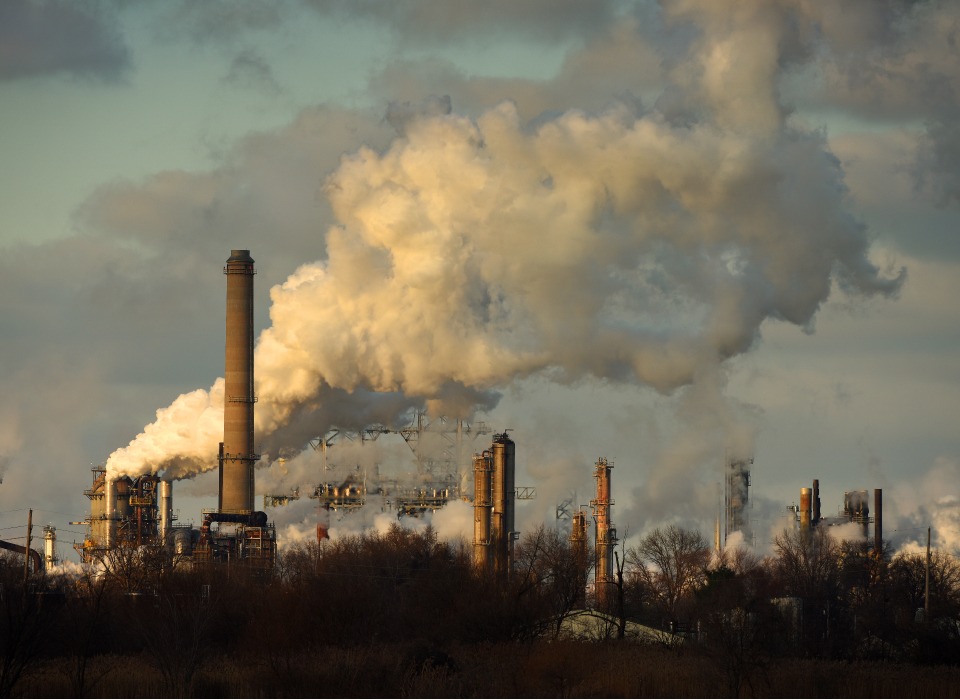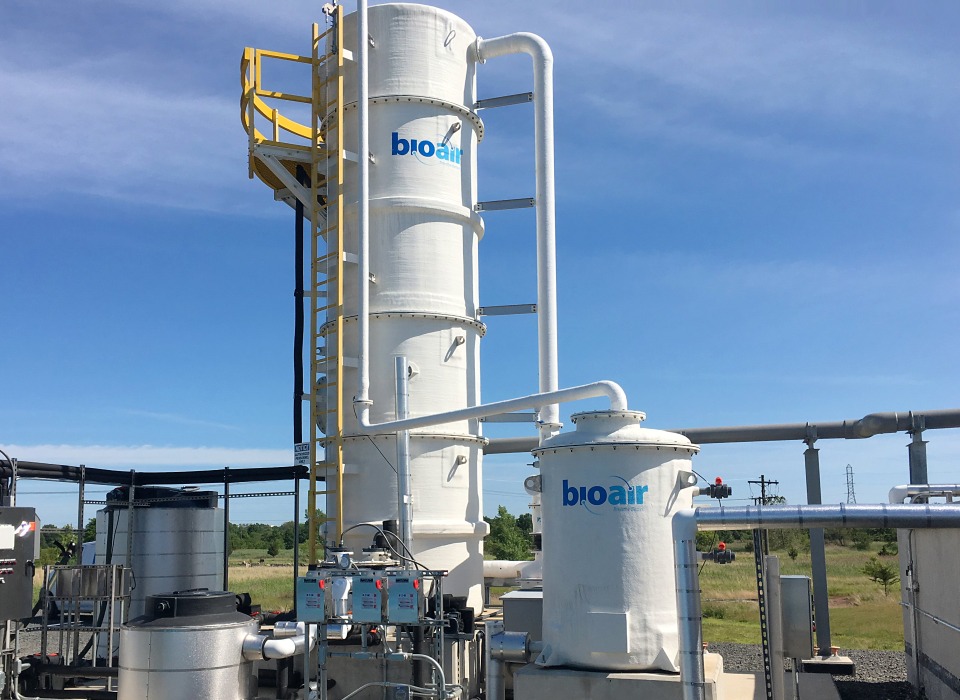Industrial VOC treatment methods haven’t changed much in the last 20 years. Most companies craft a VOC treatment strategy that centers on thermal oxidizers. But reliance solely on thermal oxidizers will hold industrial companies back with:
- Volatile operating costs due to high energy usage
- High emissions in the face of upcoming greenhouse gas (GHG) regulations
- Generation of Sulfur Dioxide (SO2) pollution as a byproduct
Environmentally sustainable VOC treatment systems haven’t been available to industry, until now. BioAir’s EcoClear® biological reactor “consumes” VOCs at industrial scale at a fraction of the operating cost. Whenever EcoClear® can be introduced as a treatment technology, your carbon footprint is reduced compared to thermal oxidation technology.
This article addresses the challenges associated with thermal oxidizers and other currently available VOC removal technologies — challenges related to existing emissions regulations as well as those on the horizon — and introduces a technology that can help industrial companies overcome those challenges.
Thermal oxidizers then and now
Thermal oxidizers became the technology of choice for VOC treatment in the 1990s. At the time, they were the most viable solution available in terms of VOC destruction performance and cost of operation. And they’ve kept millions of tons of harmful VOCs from entering the atmosphere in the years since.
These systems have grown into a standardized solution offering with well-understood performance from a well-known process. Their familiarity makes operation straightforward and predictable. In that way they’re a safe choice for facilities in need of new VOC treatment equipment.
But, notwithstanding some improvements over the years, thermal oxidizers offer similar performance now as they did when developed. And their significant financial and ecological costs have become an accepted annual line-item expense and impact. But can this change?

The challenges associated with thermal oxidation systems
Thermal oxidizers treat VOCs through combustion. Fumes enter a heating chamber kept above the incineration temperature of the VOCs, normally well above 1400°F, and are incinerated, causing them to break down into CO2 and steam, which are then released into Earth’s atmosphere. If the airstream includes hydrogen sulfide (H2S) then sulfur dioxide (SO2) is created and emitted as well.
Carbon dioxide emissions resulting from fossil fuel and industrial processes contribute to 65% of GHG emissions worldwide. And thermal oxidizers play a major role in CO2 emissions. Not only do they break down fumes into CO2, but they require supplemental fuels to be burned, which only adds to these emissions.
On top of heavy carbon footprints, thermal oxidizers impact operational budgets with volatile energy costs because they must operate at such high temperatures.
Thermal oxidizers generally fall into one of three subcategories: direct-fire thermal oxidizers, recuperative oxidizers and regenerative thermal oxidizers (RTOs). RTO systems are the most efficient of the three: They operate at around 95% efficiency but are unable to destroy all VOCs. Benzene is one VOC that requires temperatures above 1800°F for destruction.
When benzene is present, direct-fire thermal oxidation is needed, along with the corresponding increase in energy costs, and a reduced operating efficiency.
All three types of thermal oxidizers contribute heavily to man-made climate change through greenhouse gas emissions (GHG). And all three, even RTOs, incur high operating costs that fluctuate based on energy prices.
Most industrial facilities have tolerated the high operating cost of thermal solutions for a long time. But, as the ecological, political and social costs of these systems surge, companies are shifting their air treatment goals and methods.
Global shifts drive the need for change
Current international VOC treatment methods were primarily informed by regulations stemming from the Clean Air Act, Occupational Safety and Health Administration (OSHA) and the World Health Organization’s Air quality guidelines. The focus of those documents was entirely trained on toxic compounds, both organic and inorganic.
Serious, targeted regulation of VOCs, especially BTEX compounds (benzene, toluene, ethylbenzene, xylene) began following the 1990 amendment to the Clean Air Act, which produced a detailed list of around 190 regulated emissions.
At the time, thermal oxidizers offered the most viable and highest-performing VOC treatment option on the market. They became the most widely used treatment technology.
Today’s global environmental policy targets greenhouse gas emissions
Beginning with the Kyoto Protocol, climate regulation widened its focus to target GHG reduction in addition to VOC reduction. The 2015 Paris Agreement saw many world leaders agree on a framework for continued GHG emission reductions. Decarbonization is building momentum and many industry leaders have set carbon-neutral targets for their companies.
The recent Inflation Reduction Act of 2022 presents a plan for the U.S., among the largest national sources of GHG emissions worldwide, to achieve carbon neutrality by 2050. It will reward industrial decarbonization efforts by dedicating tens of billions of dollars in tax credits, guaranteed loans and direct subsidies for projects that reduce GHG and carbon reliance.
Regulatory bodies are rewarding carbon footprint reductions, and fees on methane emissions beginning in 2024 signal their intent to punish GHG emissions moving forward. And uncertainty about ongoing energy regulation and access drives volatile energy costs.
Many industrial companies have set goals for carbon footprint reduction. These are daunting goals to achieve. Reliance on pre-existing technologies places limitations on what can be accomplished. Just as changes are needed if we are to improve the quality of our atmosphere, changes in the technology to achieve this are required as well. BioAir has been pursuing this goal since its inception. We are proud to provide our EcoClear® technology as a new and impactful tool to advance these efforts.

Industrial technology powered by a paradigm shift — and bacteria
When industrial companies first adopted thermal oxidizers, treating VOCs with bacteria was not a concept that was being seriously considered at scale due to limited research and understanding of the biological processes involved. Companies needing to curb air pollution have lacked an industrial scale biological technology that could treat VOCs and mitigate GHG emissions. Until now.
After 14 years of R&D at BioAir Solutions, we’ve demonstrated the viability of biological VOC treatment at industrial scale. Our patented EcoClear® reactor resulted from a drastic shift in VOC-treatment approach from chemistry to biology and is the only available solution of its kind.
The EcoClear® system doesn’t use thermal energy or hazardous chemistry to mitigate VOC emissions. It uses biochemistry and water. Instead of blowing the untreated airstream through an incineration chamber, it is blown through a “bioreactor” designed to house a diverse population of bacteria to treat the various VOCs in the air.
The bacteria consume and convert dangerous VOC components into environmentally friendly compounds. The natural lifecycle of the bacteria allows them to reproduce and regenerate resulting in a continuous flow steady-state system. With reasonable care, the system will deliver high-performance VOC removal at a fraction of the operating costs and GHG emissions associated with thermal oxidation systems.
For some applications, EcoClear® technology can supplement a thermal oxidizer to eliminate its production of harmful emissions such as sulfur dioxide. For other applications, EcoClear® reactors could entirely replace thermal oxidizers. Across a variety of use cases and deployments, this unique approach leads to safer facilities and more sustainable VOC treatment. Where an EcoClear® system can be installed upstream of a needed thermal oxidizer, it reduces the H2S and the resultant formation of SO2. Since SO2 is a regulated pollutant, its reduction has a significant beneficial impact.
There are other applications where BioAir’s technologies provide an option for a biological solution. For example, where reduced sulfur compounds such as H2S are the primary challenge, the use of a biological solutions on its own is possible. These H2S compounds can present safety and corrosion risks and are a prime source of complaints if fugitive odors reach neighbors. Bacteria can perform quite well in consuming H2S and other reduced sulfur compounds. Thus, BioAir’s EcoClear® technology is capable of treating H2S, mercaptans and VOCs in a single reactor vessel.
How biological treatment impacts your company
This technology’s value comes from its ability to treat VOCs at comparatively negligible operating costs. By switching from an RTO to an EcoClear® system for your biologically treatable VOCs, you can end your dependence on fuel and slash your carbon footprint, doing so in an environmentally friendly and sustainable way.
How does it cut operating expenses? First, by operating at essentially ambient temperatures, it saves companies the cost of keeping heating chambers at temperatures over 1400°F. Second, it eliminates the need for additional fuel — the system mainly needs only water. Data from a 2019 study suggests thermal oxidizers accrue hundreds of thousands of dollars in fuel costs per year. Biological treatment could essentially eliminate those costs.
How does it reduce your carbon footprint? While thermal oxidation systems trade out VOCs for CO2, the bacteria in the EcoClear® system consume the H2S and VOC pollutants as the food for their own growth. A fraction of that carbon is released by the bacteria as CO2 — typically between 10 and 15% of the amount emitted by an RTO system processing the same airstream flow.
Upgrading to an EcoClear reactor from an thermal oxidation system is not a small-scale optimization towards better sustainability and a healthier balance sheet. It is an impactful step in preparing your company for a future where decarbonization is non-negotiable.
Interested in a more sustainable VOC treatment system?
Your company may have absorbed the drawbacks of RTOs for a long time. But now that can change. And soon enough, tightening climate regulations could force your hand.
With government incentives becoming available and a new one-of-a-kind technology ready to make a drastic impact on your operational budget, you should talk to an expert soon. We’ll help you determine whether a biological reactor is right for your facility. If it is, we’ll design a custom-tailored system to meet your financial and ecological sustainability goals.
